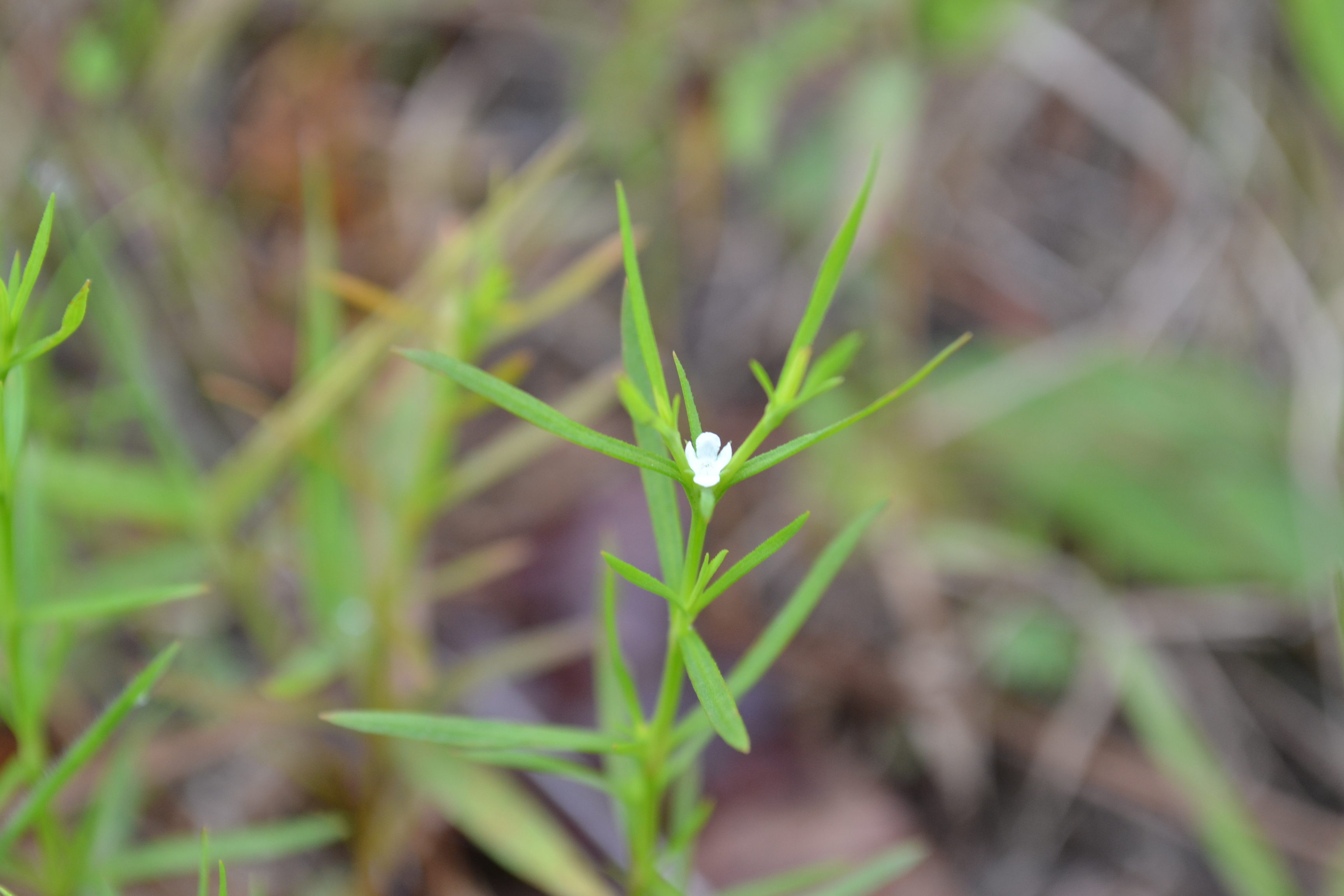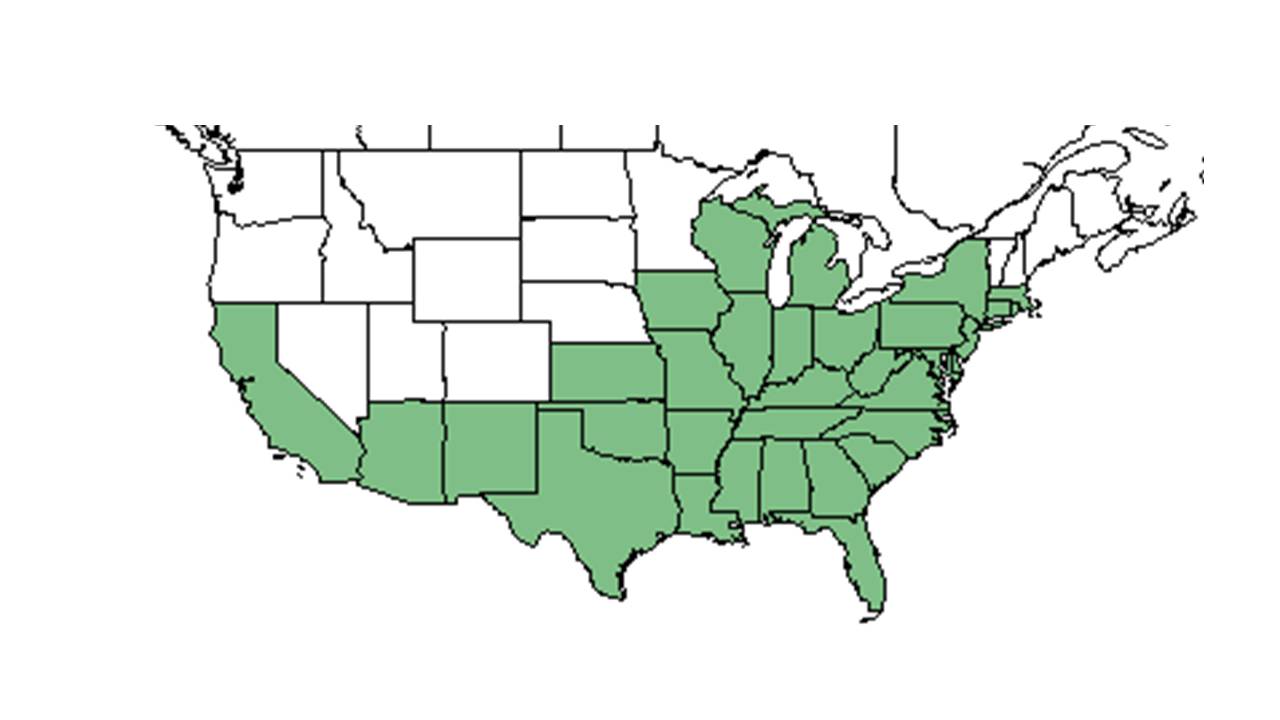Difference between revisions of "Diodella teres"
(→Taxonomic notes) |
|||
| (One intermediate revision by the same user not shown) | |||
| Line 20: | Line 20: | ||
Common name: Poorjoe | Common name: Poorjoe | ||
==Taxonomic notes== | ==Taxonomic notes== | ||
| − | Synonyms: ''Hexasepalum teres'' (Walter) J.H. Kirkbride; ''Diodia teres'' Walter | + | Synonyms: ''Hexasepalum teres'' (Walter) J.H. Kirkbride; ''Diodia teres'' Walter<ref name=weakley>Weakley, A.S. 2020. Flora of the Southeastern United States. Edition of 20 October 2020. University of North Carolina at Chapel Hill, Chapel Hill, North Carolina.</ref> |
| − | Varieties: ''Diodia teres'' var. ''hirsutior'' Fernald & Griscom; ''Diodia teres'' var. ''hystricina'' Fernald & Griscom; ''Diodia teres'' var. ''oblongifolia'' Fernald; ''Diodia teres'' Walter var. ''setifera''; ''Diodia teres'' var. ''teres''<ref name=weakley/> | + | Varieties: ''Diodia teres'' var. ''hirsutior'' Fernald & Griscom; ''Diodia teres'' var. ''hystricina'' Fernald & Griscom; ''Diodia teres'' var. ''oblongifolia'' Fernald; ''Diodia teres'' Walter var. ''setifera''; ''Diodia teres'' var. ''teres''<ref name=weakley/> |
==Description== | ==Description== | ||
| Line 45: | Line 45: | ||
===Phenology=== <!--Timing off flowering, fruiting, seed dispersal, and environmental triggers. Cite PanFlora website if appropriate: http://www.gilnelson.com/PanFlora/ --> | ===Phenology=== <!--Timing off flowering, fruiting, seed dispersal, and environmental triggers. Cite PanFlora website if appropriate: http://www.gilnelson.com/PanFlora/ --> | ||
| − | General flowering time of ''D. teres'' is between June and December.<ref name= | + | General flowering time of ''D. teres'' is between June and December.<ref name=weakley/> Flowering has been observed from May through October with peak inflorescence in July and September, and fruiting has been observed in June through November.<ref name=fsu/><ref>Nelson, G. PanFlora: Plant data for the eastern United States with emphasis on the Southeastern Coastal Plains, Florida, and the Florida Panhandle. www.gilnelson.com/PanFlora/ Accessed: 2 MAY 2019</ref> Flowers can range in color from white to purple.<ref name= "lady bird">[[https://www.wildflower.org/plants/search.php?search_field=&newsearch=true]] Lady Bird Johnson Wildflower Center. Accessed: May 2, 2019</ref> |
===Seed dispersal=== | ===Seed dispersal=== | ||
Latest revision as of 19:57, 25 May 2023
| Diodella teres | |
|---|---|

| |
| Photo taken by Kevin Robertson | |
| Scientific classification | |
| Kingdom: | Plantae |
| Division: | Magnoliophyta - Flowering plants |
| Class: | Magnoliopsida – Dicotyledons |
| Order: | Rubiales |
| Family: | Rubiaceae |
| Genus: | Diodella |
| Species: | D. teres |
| Binomial name | |
| Diodella teres Walter | |

| |
| Natural range of Diodella teres from USDA NRCS Plants Database. | |
Common name: Poorjoe
Contents
Taxonomic notes
Synonyms: Hexasepalum teres (Walter) J.H. Kirkbride; Diodia teres Walter[1]
Varieties: Diodia teres var. hirsutior Fernald & Griscom; Diodia teres var. hystricina Fernald & Griscom; Diodia teres var. oblongifolia Fernald; Diodia teres Walter var. setifera; Diodia teres var. teres[1]
Description
Generally, for Diodia genus (this description is from Radford 1964. Diodella was not an accepted name at the time) they are "annual or perennial herbs. Leaves sessile, opposite pubescent or glabrate, margins hyaline, setose-serrate; stipules linear or fimbriate, ½ as long, or longer than, the fruit. Flowers 4-merous, axillary, usually solitary, sessile; calyx lobes equal or unequal; corolla salverform. Fruit leathery, surmounted by the persistent calyx lobes, splitting into 2, indehiscent, 1-seeded segments." [2]
Specifically, for D. teres, they are "erect or spreading, usually pubescent perennial from a woody root crown, the stems branched, 1-6 dm or more long. Leaves elliptic-lanceolate to oblanceolate, mostly 2-7 cm long, 4-21 mm wide. Calyx lobes 2, linear-lanceolate, 4-6 mm long, pubescent; corolla white, tube 4-5 mm long, glabrous; stigma 2-lobed. Fruit hispid, obpyriform, 2.5-4 mm long, with a single longitudinal furrow. Fruit splitting into 2, indehiscent, 1-seeded segments." [2]
Distribution
D. teres can be found across the United States, from New York and Massachusetts, west to Michigan and Wisconsin, south to Florida, and further west to Iowa, Kansas, New Mexico, Arizona, and California.[3] This species is also native to Mexico as well as Central America.[1] It is native across its range in the United States, except for Michigan and Massachusetts where it is considered exotic.[4]
Ecology
Habitat
Generally, this species can be found in sandy roadsides, dunes, hardpans, glades, and other dry habitats.[1] D. teres occurs in semi-shaded to open areas and well-drained sandy soil.[5] It can be found in longleaf pine savannas,[6] turkey oak sand ridges, mixed hardwood forests, exposed coastal dunes, coastal hammocks, and scrub hills.[5] One study found D. teres to grow on gopher tortoise mounds that exclusively were recently abandoned.[7]
This species decreased significantly in response to clearcutting and thinning timber in one study.[8] However, it still occurs in some disturbed habitats, including roadsides and railroad yards.[5] As well, disking at sites has shown to increase the frequency of this plant.[9]
D. teres has shown positive regrowth in reestablished longleaf pine woodlands that were disturbed by agricultural practices to in South Carolina's coastal plains, making it an indicator species for post-agricultural woodlands.[10] D. teres was found to have mixed responses to soil disturbance by roller chopping and clearcutting in north and northwest Florida sandhills. The plant's regrowth in reestablished pine habitats tended to be dependent upon time since disturbance.[11][12]
In the Piedmont, it has been observed to occur in areas of washing with most or all of the A horizon destroyed.[13]
Associated species include Toxicodendron, Rubus cuneifolius, Pteridium aquilinum, Elephantopus tomentosus, Triplasis purpurea, Crotalaria, Desmodium, D. virginiana, Serenoa repens, live oak, pine.[5]
Phenology
General flowering time of D. teres is between June and December.[1] Flowering has been observed from May through October with peak inflorescence in July and September, and fruiting has been observed in June through November.[5][14] Flowers can range in color from white to purple.[15]
Seed dispersal
This species is thought to be dispersed by gravity.[16]
Fire ecology
This species has been found in frequently burned areas, including annually burned pinelands[5] such as those on the Pebble Hill plantation in North Florida.[17][18] It appears to benefit especially from high fire frequency (in the Osceola study plots).[19] One study found density of D. teres to not significantly change in response to reintroduction of fire.[20]
Pollination
Diodella teres has been observed at the Archbold Biological Station to host sweat bees such as Augochloropsis sumptuosa (family Halictidae) and thread-waisted wasps such as Prionyx thomae (family Sphecidae).[21] Additionally, this species has been observed to host sweat bees from the family Halictidae such as Augochlora pura[22], Halictus parallelus and Lasioglossum vierecki, and leafcutting bees from the Megachilidae family such as Megachile albitarsis, M. mendica and M. texana.[23]
Herbivory and toxicology
D. teres consists of approximately 5-10% of the diet for large mammals and various terrestrial birds.[24] It is an important food to bobwhites in the summer months.[25] It is also a principal food for the morning dove in north-central Florida in October and December.[26] As well, gopher tortoises (Gopherus polyphemus) have been observed foraging on D. teres, and was found in their scat.[27]
Conservation, cultivation, and restoration
This species can be considered weedy or invasive in some habitats, according to sources in Kentucky.[3]
Cultural use
Photo Gallery
References and notes
- ↑ 1.0 1.1 1.2 1.3 1.4 Weakley, A.S. 2020. Flora of the Southeastern United States. Edition of 20 October 2020. University of North Carolina at Chapel Hill, Chapel Hill, North Carolina.
- ↑ 2.0 2.1 Radford, Albert E., Harry E. Ahles, and C. Ritchie Bell. Manual of the Vascular Flora of the Carolinas. 1964, 1968. The University of North Carolina Press. 979. Print.
- ↑ 3.0 3.1 USDA, NRCS. (2016). The PLANTS Database (http://plants.usda.gov, 2 May 2019). National Plant Data Team, Greensboro, NC 27401-4901 USA.
- ↑ [[1]] NatureServe Explorer. Accessed: May 2, 2019
- ↑ 5.0 5.1 5.2 5.3 5.4 5.5 Florida State University Robert K. Godfrey Herbarium database. URL: http://herbarium.bio.fsu.edu. Last accessed: June 2014. Collectors: Loran C. Anderson, Tom Barnes, A. F. Clewell, D. L. Fichtner, J. P. Gillespie, R. K. Godfrey, Bruce Hansen, R. Kral, Robert L. Lazor, Cecil R. Slaughter, Gwynn W. Ramsey, H. Larry Stripling, Brenda Herring, Wendy Zomlefer, Mabel Kral, D. W. Mather, F. C. Craighead, R. A. Norris, R. Komarek, Edwin L. Tyson, and JoAnn Hansen. States and Counties: Florida: Alachua, Bay, Citrus, Dade, Duval, Escambia, Franklin, Highland, Holmes, Jefferson, Lake, Leon, Liberty, Madison, Marion, Okaloosa, Orange, Polk, Santa Rosa, St. Johns, Taylor, Wakulla, and Walton. Georgia: Grady and Thomas. Other countries: Panama.
- ↑ Heuberger, K. A. and F. E. Putz (2003). "Fire in the suburbs: ecological impacts of prescribed fire in small remnants of longleaf pine (Pinus palustris) sandhill." Restoration Ecology 11: 72-81.
- ↑ Kaczor, S. A. and D. C. Hartnett (1990). "Gopher tortoise (Gopherus polyphemus) effects on soils and vegetation in a Florida sandhill." American Midland Naturalist 123: 100-111.
- ↑ Brockway, D. G. and C. E. Lewis (2003). "Influence of deer, cattle grazing and timber harvest on plant species diversity in a longleaf pine bluestem ecosystem." Forest Ecology and Management 175: 49-69.
- ↑ Olinde, M. W. (2000). Vegetation response to disking on a longleaf pine site in southeastern Louisiana. Quail IV: Proceedings of the Fourth National Quail Symposium, Tallahassee, FL, Tall Timbers Research, Inc.
- ↑ Brudvig, L.A., E Grman, C.W. Habeck, and J.A. Ledvina. (2013). Strong legacy of agricultural land use on soils and understory plant communities in longleaf pine woodlands. Forest Ecology and Management 310: 944-955.
- ↑ Hebb, E.A. (1971). Site Preparation Decreases Game Food Plants in Florida Sandhills. The Journal of Wildlife Management 35(1):155-162.
- ↑ Lewis, C.E., G.W. Tanner, and W.S. Terry. (1988). Plant responses to pine management and deferred-rotation grazing in north Florida. Journal of Range Management 41(6):460-465.
- ↑ McQuilkin, W. E. (1940). "The Natural Establishment of Pine in Abandoned Fields in the Piedmont Plateau Region." Ecology 21(2): 135-147.
- ↑ Nelson, G. PanFlora: Plant data for the eastern United States with emphasis on the Southeastern Coastal Plains, Florida, and the Florida Panhandle. www.gilnelson.com/PanFlora/ Accessed: 2 MAY 2019
- ↑ [[2]] Lady Bird Johnson Wildflower Center. Accessed: May 2, 2019
- ↑ Kirkman, L. Katherine. Unpublished database of seed dispersal mode of plants found in Coastal Plain longleaf pine-grasslands of the Jones Ecological Research Center, Georgia.
- ↑ Robertson, K.M. Unpublished data collected from Pebble Hill Fire Plots, Pebble Hill Plantation, Thomasville, Georgia.
- ↑ Glitzenstein, J. S., D. R. Streng, R. E. Masters, K. M. Robertson and S. M. Hermann 2012. Fire-frequency effects on vegetation in north Florida pinelands: Another look at the long-term Stoddard Fire Research Plots at Tall Timbers Research Station. Forest Ecology and Management 264: 197-209.
- ↑ Glitzenstein, J. S., D. R. Streng, et al. (2003). "Fire frequency effects on longleaf pine (Pinus palustris, P.Miller) vegetation in South Carolina and northeast Florida, USA." Natural Areas Journal 23: 22-37.
- ↑ Duncan, R. S., et al. (2008). "The effect of fire reintroduction on endemic and rare plants of a southeastern glade ecosystem." Restoration Ecology 16: 39-49.
- ↑ Deyrup, M.A. and N.D. 2015. Database of observations of Hymenoptera visitations to flowers of plants on Archbold Biological Station, Florida, USA.
- ↑ Deyrup, M. J. E., and Beth Norden (2002). "The diversity and floral hosts of bees at the Archbold Biological Station, Florida (Hymenoptera: Apoidea)." Insecta mundi 16(1-3).
- ↑ Discoverlife.org [3]
- ↑ Miller, J.H., and K.V. Miller. 1999. Forest plants of the southeast and their wildlife uses. Southern Weed Science Society.
- ↑ Jones, J. D. J. and M. J. Chamberlain (2004). "Efficacy of herbicides and fire to improve vegetative conditions for northern bobwhites in mature pine forests." Wildlife Society Bulletin 32: 1077-1084.
- ↑ Beckwith, S. L. (1959). "Mourning Dove Foods in Florida during October and December." The Journal of Wildlife Management 23(3): 351-354.
- ↑ Carlson, J. E., et al. (2003). "Seed dispersal by Gopherus polyphemus at Archbold Biological Station, Florida." Florida Scientist 66: 147-154.